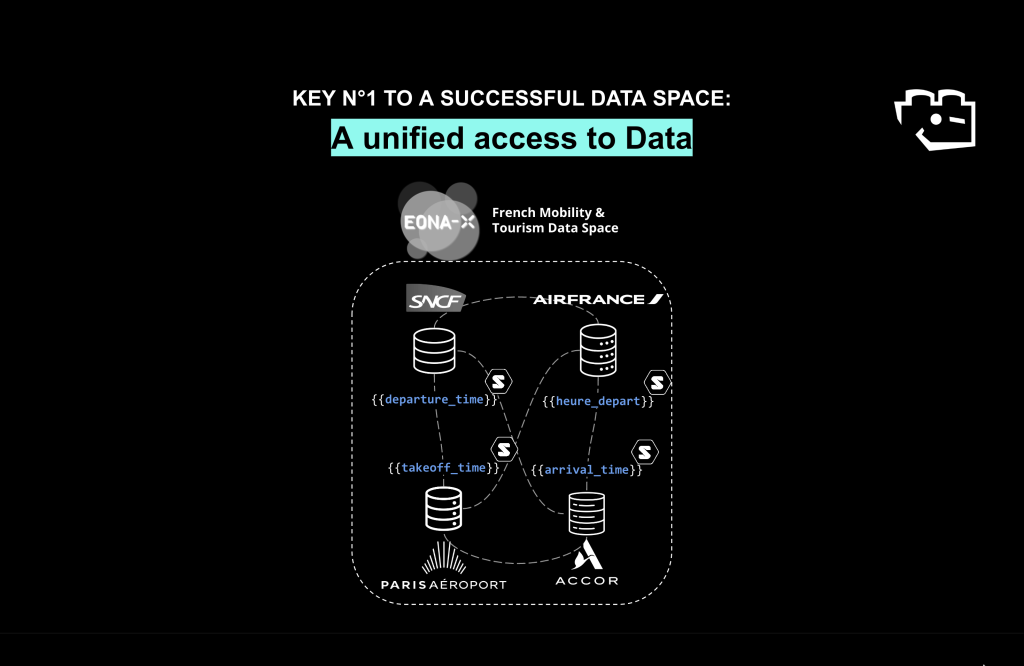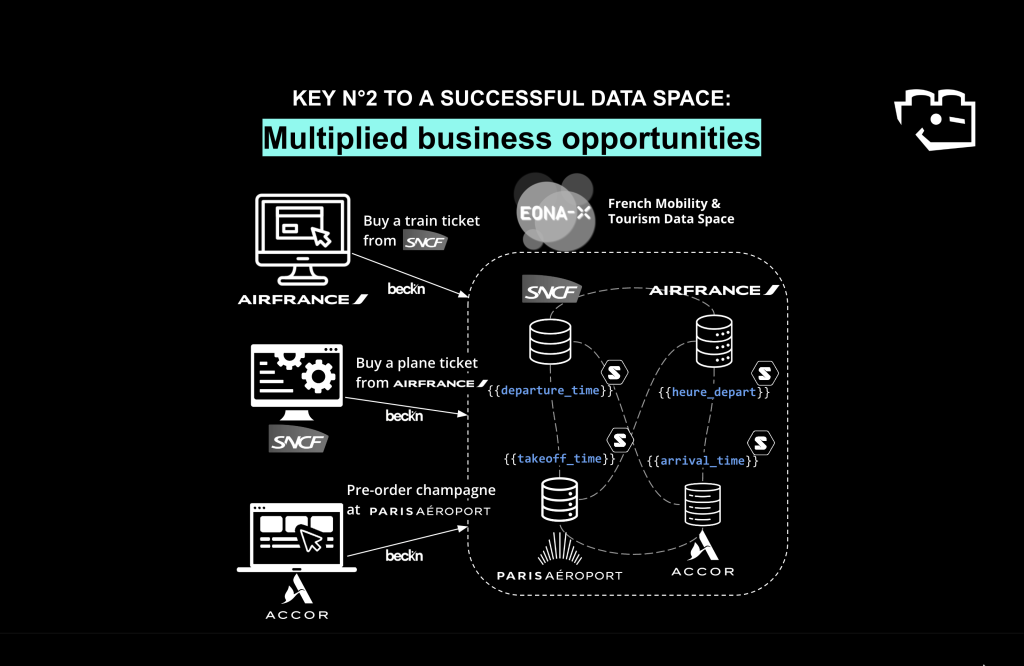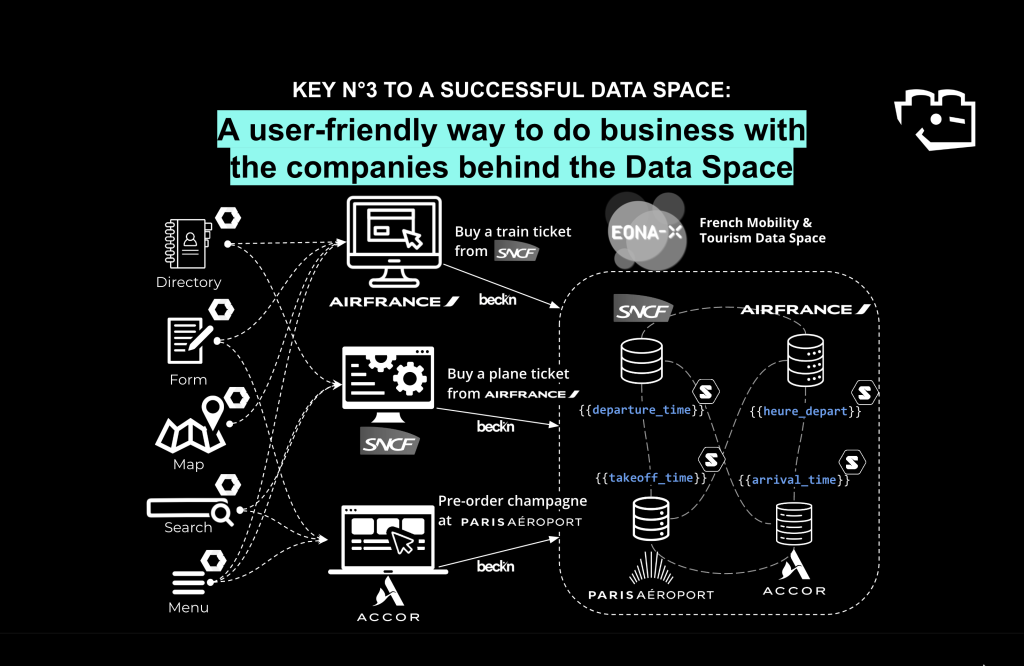Data Spaces are now a global movement. Initiated in Europe, we already see them replicated in the United States, in China and in India. Of course the shapes and forms vary, as well as the way to get there, and nobody is so sure yet what they are, and how to use them.
At Startin’blox, we have been involved in the creation of interoperable and decentralized data spaces for 5 years, working on 30 different projects in 3 different continents. In this article, we want to share our experience about how to build Data Spaces that are part of the current digital economy, and not outlandish.
From siloed platforms to interoperable ecosystems
The web economy is currently handled by a handful of siloed platforms that lock their users in, and encapsulate their data in a black box. If as a shop owner, I upload my products on Amazon to sell online for example, I can only sell on Amazon. I cannot reuse the data of my products to sell on another platform. I cannot reuse the goodwill I’ve built with my customers on another platform. My products’ data is locked in. My user account is locked in.
To integrate these platforms to data spaces, or to create data spaces that can compete on their turf, one necessary step is data interoperability, i.e. having web platforms where data is not locked in, and where user accounts are not locked in. The World Wide Web Consortium (W3C) has been working on this challenge for as long as the Web has existed, that is to say more than 30 years, and has come up with a set of standards to make these “Data Space enabled” platforms possible. To name a few for the connoisseurs in the audience: Verifiable Credentials (VC), Decentralized Identifiers (DID), Resources Description Framework (RDF), Linked Data Platform (LDP), Access Control Policy (ACP), Linked Data Notifications (LDN).
To simplify communication, most of these standards are gathered under a single banner: Solid. Solid aims to create interoperability between web platforms, enabling data to be expressed consistently across platforms, and to get rid of the black box effect. If all the platforms were Solid compatible, I could display my list of products registered on Amazon on other e-commerce platforms, and vice versa.

The value Data Spaces bring to their members depends on their capacity to unify access to data. By leveraging the state-of-the-art W3C Solid standards, they can unlock high-value use cases, e.g. real-time multimodal transport, otherwise impossible.
From single platforms to interconnected services
In the previous section, we saw that data interoperability between platforms is a first condition to turn them into a successful data space, but it is not enough. Having a common way to express data, e.g. the departure time of a transport, does not create any revenue. In order to add business value to this data sharing, they need to integrate it to their business model and foster revenue. This is where transactions come into play.
A transaction is a purchase, from a buyer to a seller. When I’m ordering food online, when I’m ordering a ride, when I’m buying a product: I’m issuing a transaction. Transactions today are happening within the platforms’ black boxes. As an example, I can only buy a ride from a specific driver on Uber, if it is the app she has registered herself on. I cannot use another application to issue that transaction.
Beckn is a decentralized protocol to enable cross-platform transactions. Thanks to Beckn, complex multi-businesses interactions, e.g. multimodal transportation, ordering a taxi and a train ticket from a single app becomes commonplace. Different applications, potentially an infinity of them, are then able to sell the different products and services found in a given Data Space.

The value Data spaces can bring to their end users depends on their capacity to seamlessly transact with multiple businesses. By leveraging Beckn, the biggest transaction protocol in the world, Data Space bring new business opportunities to their end users, e.g. ordering a taxi and a train ticket in a single transaction.
From a couple of gatekeepers to a galaxy of Data Space applications
So the data of our platforms are now compatible with one another thanks to Solid, and we can now trigger sales from any application to any company thanks to Beckn. Is this enough to integrate Data Spaces into the Web economy?
Well… how will the end users interact with the data space? Today, we use applications to interact with the data of the services that we use and to trigger transactions. When I shop on Amazon, I use an app that displays useful data to me, i.e. about the gym pants that I want to buy, and I issue a transaction when I end up buying my sexy tiger leggings (do not judge me). As an end-user, I have no clue about data standards, interoperability and decentralized transactions. All I care about is my user-friendly app and my privacy, I don’t want to know what’s behind it.
If we want Data Spaces to become part of the Web, they need to disappear. From the end user’s perspective, they need to become a pleasant shopping experience, a nice source of information or a useful service. They need to offer interfaces as diverse as the different use cases that exist among their end-users. Applications are the interface to access what the web has to offer today, and they will continue to be once Data Spaces blend with the web. A myriad of applications will be vying to become our favorite interface to carry on a specific type of transactions, e.g. ordering a car ride.
Web components is a standard fostering modularity and reusability on the web. By bringing this modularity to data spaces, web components bring data spaces into the hands of the end-users, without them knowing about data spaces at all. For instance, the cart component that I use to buy my sexy leggings can be a web component shared by thousands of over web platforms, lowering the cost to develop them and improving the overall quality and user experience. Modularity is therefore key to scaling data space beyond the niche of early adopters.

The amount of financial interactions end users will have with their Data Spaces directly depends on their user-friendliness. Thanks to Web Components , Startin’blox offers super-powered applications, e.g. ordering my entire transport journey from the website of my airline.
Wrapping up
We do not mean to pretend we have all the answers. Which company is responsible for customer support when a traveler is having an issue with her multimodal train-plane-taxi ticket? How to ensure a quality delivery in a world where an infinity of platforms can sell your products? How not to overwhelm the end user with info in a world where theoretically every platform can sell any service or product? We do not know.
What we know is that there is a way to integrate Data Spaces to the Web economy, with production ready protocols and identified value-added use cases. Our goal is to ease the integration of data spaces for any end-user, individual or small business, big corporation or public administration.
If this prospect sounds exciting, if you think we are daydreaming, or if you simply have a comment you’d like to share, please reach out at alex@startinblox.com.



